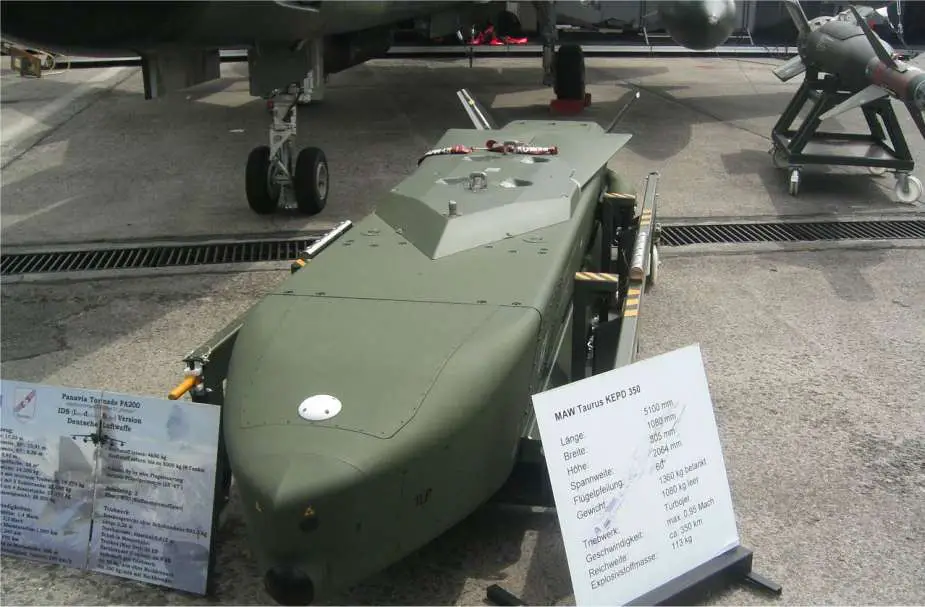Breaking news
Army Recognition Editorial Team Highlights German Taurus Missile's Potential for Ukraine.
The Army Recognition editorial team details the potential advantages that the German Taurus air-launched cruise missile could offer to Ukrainian forces. Despite Germany's decision to not deliver the missile's delivery due to compatibility concerns with equipment from France and the UK, the missile's technical prowess and combat capabilities remain undeniable. Additionally, Germany's reservations stem from fears that the missile might be used against strategic targets like the Kerch Bridge, connecting Russia to the annexed Crimean peninsula.
Follow Army Recognition on Google News at this link

German Taurus air-launched cruise missile. (Picture source Wikimedia)
The Taurus missile, a product of Taurus Systems GmbH—a collaboration between MBDA Deutschland GmbH and Saab Dynamics AB—is renowned for being one of the world's most sophisticated air-launched cruise missiles. With a range of approximately 500 km (310 miles) and the ability to travel at subsonic speeds, it is designed to penetrate dense air defenses and target high-value assets. Its dual-stage warhead is tailored to neutralize hard and deeply buried targets. The missile employs a combination of GPS/INS for mid-course guidance and an imaging infrared (IIR) seeker for terminal accuracy.
However, the potential use of the Taurus missile by Ukrainian forces has raised concerns in the international community. Former UK Defence Secretary, Ben Wallace, has urged Germany to supply the Taurus cruise missiles to Ukraine, especially in light of recent Russian attacks on civilian infrastructure in the country. On 5 October, Russian forces launched a significant attack on the village of Hroza in the Kharkiv Oblast, resulting in the tragic loss of at least 51 lives. This incident marked one of the most severe attacks by Russian troops in the Kharkiv region since the onset of the full-scale invasion.
Germany's reluctance to supply the Taurus missiles is further compounded by fears that they could be used to target the strategically vital Kerch Bridge, which connects Russia to the annexed Crimean peninsula. German Chancellor Olaf Scholz, on 5 October, mentioned that while Germany hasn't made a final decision on the missile supply, they are keen on preventing any escalation of the war.
The unfolding situation underscores the delicate balance nations must maintain between supporting allies and averting potential escalations in conflict-prone regions. The international community remains vigilant, as decisions like these not only influence the military equilibrium in Eastern Europe but also set precedents for future arms transactions in volatile areas.
The Taurus missile, known specifically as the Taurus KEPD 350, stands as a testament to the collaboration between MBDA Deutschland GmbH (previously known as LFK) and Saab Dynamics AB. This joint venture, under the banner of Taurus Systems GmbH, led to the creation of one of the world's most advanced cruise missiles. Designed with a specific purpose in mind, the Taurus missile is adept at penetrating robust air defenses to strike high-value targets. This makes it an ideal choice for both pre-planned missions and unexpected targets of opportunity.
When it comes to its technical specifications, the Taurus missile boasts an impressive range of approximately 500 km, which translates to about 310 miles. It travels at subsonic speeds and is equipped with a dual-stage warhead, specifically engineered to neutralize hard and deeply buried targets. For its navigation, the missile relies on a combination of GPS/INS for its mid-course trajectory and employs an imaging infrared (IIR) seeker for precise terminal guidance.
In terms of deployment, the Taurus missile has been integrated into various aircraft platforms. Notable mentions include the Panavia Tornado and the Eurofighter Typhoon. Its excellence hasn't gone unnoticed on the global stage, leading to its export to several countries.
Its operational use showcases its resilience and adaptability. The Taurus missile is crafted to withstand the challenges posed by modern air defense systems. Its ability to fly at extremely low altitudes helps it evade radar detection, and its stealthy design minimizes its radar cross-section.
While Germany stands as a primary user of the Taurus missile, its prowess has attracted other nations as well. Countries like Spain and South Korea have also added the Taurus missile to their arsenal, reinforcing their air forces with its high-precision, long-range strike capabilities against a diverse range of targets.
Defense News October 2023


























